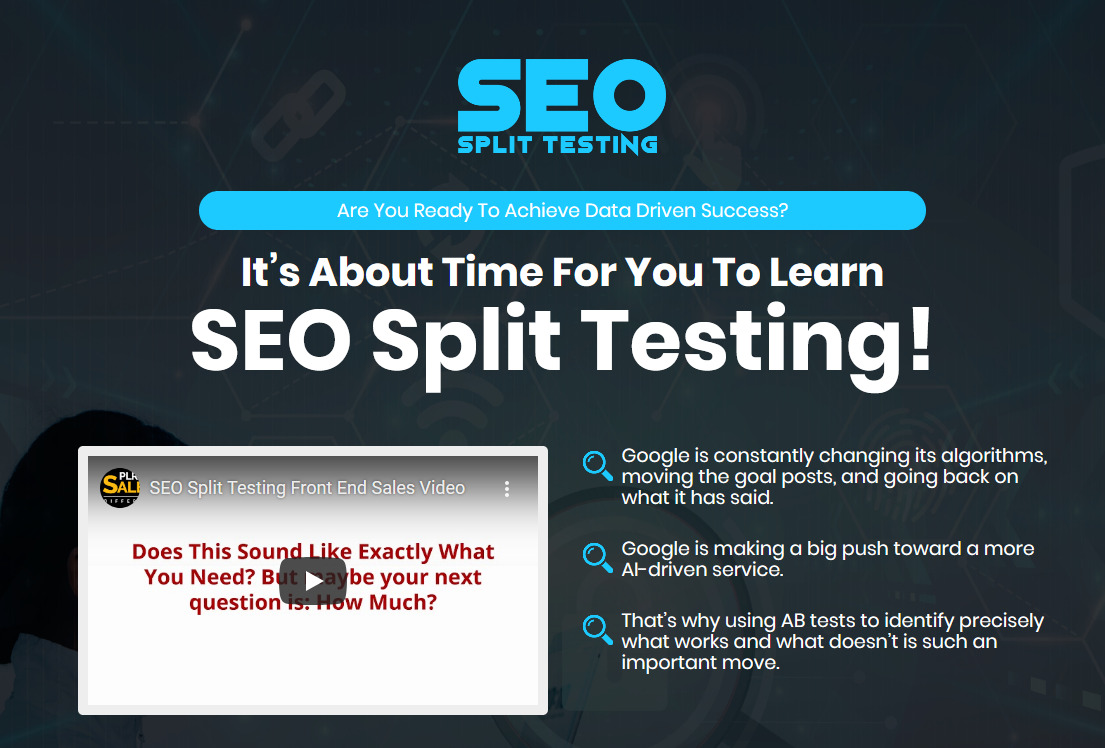Salespage Snapshot

Sample Content Preview
Split Testing for SEO
So how does this work in the world of SEO?
Well, while we’ll get into the specifics and the nitty gritty of SEO in a moment, the main thing you need to know at this point is that Google relies on a few factors when determining how prominently to feature a website in the SERPs.
For example, Google will look for the presence of keywords, it will look for the use of H1 and H2 tags (large bold text), it will look for images that have certain alt tags and filenames, and it will look for signals from users – such as the amount of time spent on the page.
The problem is, that no one knows the specifics of the algorithm. We know that Google likes sites that use keywords subtly, and our best guess is that the ideal keyword density is about 1-3% (meaning that the keyword appears one to three times in each hundred words). But we don’t know precisely how many times Google wants us to repeat the phrase, we don’t know where the tipping point is where it becomes too much. We don’t know how much Google wants to see us use related terms, and we’re not 100% sure whether it’s better to focus on just one keyword or to try a few.
Again, everyone has their opinions.
This makes it very hard to make smart decisions as a site owner. Do you include more keywords in your articles or not?
Should you use that image before the text or after it? And is it a good idea to use H1 tags, or are you better off with H2 tags?The answer is that we just don’t know. And for that reason, the best option is to run AB tests (the other term for split tests) in order to see which changes positively affect your search ranking and which do not.
So, why do we need split testing in the SEO community now more than ever? The simple answer is that SEO is more complex than it ever has been before, and we have even less idea of how it works. For a moment, let me talk about another tangentially related example: YouTube’s copyright algorithm. You see, over on YouTube, there is an algorithm designed to ensure that users don’t upload copyrighted content. This prevents YouTube from getting into legal trouble, and protects the intellectual property of music labels and movie studios – in theory anyway.
The problem is that this copyright detection can be a little gung-ho and will sometimes pick out the background music at a party and use that to file a copyright strike against the person who uploaded the video. Most people would agree that’s a little unfair!
That’s why some creators decided to test precisely how the system works. They did this by uploading hundreds of versions of the same song: versions that had been modulated up or down a semi-tone, versions that had been transposed down an octave, versions played background, versions played quietly, versions played only for short clips.
Doing all of this, allowed them to test the limits of the system and then to provide the wider community with useful rules on how to avoid being penalized. They discovered that if less than 10 seconds of content matched, then the person who uploaded the video would likely be fine. And this allowed for a whole host of fair-use practices.
SEO is just the same. Google is constantly changing its algorithms, moving the goal posts, and going back on what it has said. One minute it’s a good idea to get as many links as possible, the next moment that’s the worst thing you can do!
Right now, Google is making a big push toward a more AI-driven service. It wants the user to speak to Google using natural language, and to receive carefully curated responses drawn from the web. That is far more complex than simply looking for exact keyword matches, and it makes our job as SEOs that much harder!
That’s why using AB tests to identify precisely what works and what doesn’t is such an important move.
Then there’s the fact that this is so multivariate. For example, it might be that Google would prefer you to use a number of headers in your content with keywords in a perfect world. But what happens if you then add those headers in, only to find that this actually drives away your visitors? That alone is useful information you could garner from a split test. But it’s also possible that in driving away visitors, you send negative signals to Google and end up hurting your ranking.
Even though what you’re doing is considered GOOD from an SEO standpoint, it is working contrary to ANOTHER system within the ranking algorithm. When you take all of that into account, it becomes less obvious what you should do and this makes it all the more useful to just test it and see what actually works.
This is useful if you are a business looking to climb the ranks of Google without shooting yourself in the foot. It’s useful if you are starting out and want to adopt the very best strategy from the very start. And what’s more, this is extremely important if your are an SEO specialist or agency selling your services to a client.
At a time when nothing is certain in the world of SEO, explaining to a customer why you think they should adopt a certain strategy or employ a particular technique is difficult. But if you can show clearly that the strategy works in a controlled and SAFE environment, then you can increase your chances significantly of securing their business.
Why Split Testing is the Perfect Business Strategy
In many ways, split testing is the ‘perfect’ business strategy. If that sounds hyperbolic, then hear me out for a moment.
How can any business strategy truly be ‘perfect’ you ask?
The answer is that when employed correctly, split testing will literally ‘evolve’ your site to the point where it thrives, avoiding all the bad mistakes that you might have otherwise made along the way. So let’s say that you start out with a fairly average site that is performing very averagely in the SERPs. Using split testing, you might decide to start using more H1 tags with keywords in, or you might choose to start using images a little more. This causes a bump in your position.
You then decide to test some design changes to your site. Doing so convinces you that you should be using a slightly less busy and more modern layout. You therefore switch to a new theme for your WordPress site that looks great.
Bit by bit, you adopt more decisions that help to hone your site into the perfectly optimized design for Google, and slowly-but-surely, it climbs the ranks.
You can’t make a bad decision, because you see those mistakes coming a mile off. And if you keep tweaking, you keep on improving. In this way, split testing is the best way to evolve your site and is the closest thing to a perfect strategy there is.
You might at this point be asking why you should go to all the trouble of creating a split test, when you could just run a short trial period instead? Why color three prawn shops red and then wait for them to collect enough actionable data?
Isn’t this really just a fancy way of describing a kind of public beta test?
Well, there are a few key differences to keep in mind, which involve thinking like an actual scientist. Because that’s what this is emulating FYI: this is precisely the same technique used in research. When a researcher wants to know if a particular drug will help to boost someone’s alertness, they find out by creating two separate groups: an experimental group and a control group. The experimental group is the one that receives the drug, and the control group is the one that doesn’t. This then gives the researcher the opportunity to compare the stats from the two groups.
What this achieves is to remove confounding variables. A confounding variable is anything that can hurt your outcome, rendering the results of the study useless.
For example, if you also introduce a new exercise program to the individual taking the drug, then it might be THIS that makes them more focused, rather than the drug. That skews your results, and you therefore don’t know whether the drug or the intervention made the difference.
One of the most common confounding variables in research, is the ‘placebo effect’. This effect describes the fact that when you tell someone they’ve received a drug, they will then feel better even if the drug is just a sugar pill! The power of belief is so strong, that this can end up skewing the results as the subject’s optimism and belief helps them to dig deeper and find more focus.
That’s why the experimental group will often receive a sugar pill. This way, both groups THINK they are getting something, and you can thereby rule out the role of placebo in the study.
So back to your SEO. What does all this have to do with split testing? Well essentially, you have your experimental group and your control group. The experimental group is the one where you have introduced the new header or whatever else, and the control group is the one where you have left everything as it was.
Other Details- 20 Articles (TXT, DOC)
- 2 Ebooks (PDF, DOC), 28 Pages
- 7 Graphics (JPG, PNG)
- 1 Salespage (HTML)
- 10 Ecovers (JPG)
- 2 Promotional Ad Materials (Emails, Banners)
- Resource Report, Cheat Sheet, Mindmap, Social Media Images, Legal Page, Sales Video,
- Year Released/Circulated: 2019
- File Size: 217,835 KB
License Details:
[YES] Can be sold
[YES] Can be used for personal use
[YES] Can be packaged with other products
[YES] Can modify/change the sales letter
[YES] Can be added into paid membership websites
[YES] Can put your name on the sales letter
[YES] Can be offered as a bonus
[YES] Can be used to build a list
[YES] Can print/publish offline
[YES] Can convey and sell Personal Use Rights
[YES] Can convey and sell Resale Rights
[YES] Can convey and sell Master Resale Rights
[NO] Can modify/change the main product
[NO] Can modify/change the graphics and ecover
[NO] Can be given away for free
[NO] Can be added to free membership websites
[NO] Can convey and sell Private Label Rights














